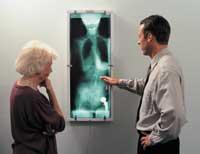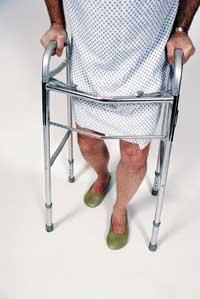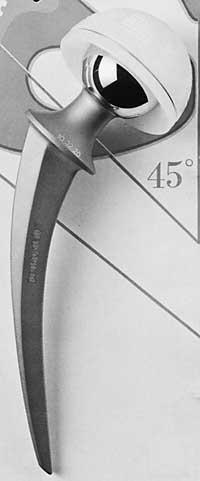Hip Prosthesis
2004/05/01 Agirre, Jabier - Medikua eta OEEko kidea Iturria: Elhuyar aldizkaria

Every year 16,000 hip prostheses are implanted, since the hip prosthesis is the only solution in many cases to eliminate pain and recover joint mobility. As Dr. Ramón Viladot, Head of the Locomotor Surgery Service at the Hospital de Sant Rafael in Barcelona, points out, “osteoarthritis causes pain, limitations to walking… These patients have difficulty walking and are very limited to perform certain hip movements. Especially with age, the head of the femur or femur can become necrotic and cause circulation problems.”
How does the hip work?
The hip joint involves two bones: the thigh and pelvis. The head of the femur is a kind of sphere or ball, embedded in the hole or hole that has expressly for it the pelvis. The ends of the bones that form the joint are covered by an articular cartilage that serves to soften or cancel the bone shock or shock. However, this continuous friction has long-term harmful effects.
Osteoarthritis produces a degeneration or degeneration of articular cartilage that produces erosion. But it can also be due to other diseases (rheumatoid arthritis, especially) or deep fractures.
Against erosion: operation
Erosion causes pain and even disability. The difficulty and pain in movement make this joint just used by the person, so the muscles weaken and the mobility of the joint becomes more difficult. In these cases, the only possible solution is to replace the joint with a prosthesis that fulfills the functions that the joint should perform by itself.
The prosthesis consists of three parts: a cavity or a kind of hole, usually made of plastic, that performs the function of the hip cavity or cotilo, a metallic sphere that acts as a substitute for the femoral head and, finally, a kind of lump that attaches to the body of the femur. These prostheses are made of stainless steel or cobalt, chrome and titanium alloys. The plastic is made of polyethylene, resistant and resistant.
The operation is done with general or epidural anesthesia. An incision is made in the affected area and the head of the femur and the cotyloid cavity of the pelvis are removed. The prosthesis is then placed and fixed. Finally, the muscles and tendons that have been separated laterally are put in place and the cut is closed.
If the patient is between 60 and 70 years old, the prosthesis may be uncemented. This type of prosthesis is attached to the bone through a kind of mesh that allows bone growth through the most natural possible union of the prosthesis. However, if the patient is over 70 years old, the prosthesis is attached to the bone with a special cement, since the quality of the bone is worse than in younger people.

The patient should stay in the hospital about a week, but may start walking with crutches the second day after the operation. Once discharged, you will need to perform rehabilitation exercises for at least one month and home aids for another 3 months. Currently the operation has very good results and the patient can lead a completely normal life. There are people who can play or ski tennis after the operation. By eliminating pain and improving mobility you can achieve an adequate and quality life, always depending on the age of the patient.
And complications, what?
The process, although it may seem simple, is quite complex and in some cases complications may occur:
- Dislocations or locations when
the Prosthesis leaves its place. It occurs shortly after the surgery and in many cases the surgeon can manually reposition it in place.
Releasing or “softening” the prosthesis
loses its fixation, directly on the bone or even on the cement. If the loss is important, it may be necessary to replace the prosthesis with a new one. Wear
of the new
joint can occur over time, especially in obese people.
The prostheses have an average duration of about fifteen years, but, according to Dr. Ramón Viladot, “you cannot predict exactly.” It depends mainly on three factors: the correct implantation of the prosthesis, the type of prosthesis chosen and the event.
Recommendations for implanted prostheses
There are a number of recommendations that people with hip prostheses should follow to prevent erosion.
- Do not cross your legs. This position can facilitate the dislocation or mooring of the prosthesis.
Beware of infections. Infections that appear anywhere in the body should be treated immediately to prevent migration and infection of the prosthesis.
Airport controls. Ask the surgeon to prove that you are wearing prostheses, as the metal that carries the prosthesis can trigger alarm detectors at airport controls.
Latest surgical techniquesThere are mini-invasive surgery techniques, including prosthesis implants, which incorporate a number of improvements:
|

Gai honi buruzko eduki gehiago
Elhuyarrek garatutako teknologia





